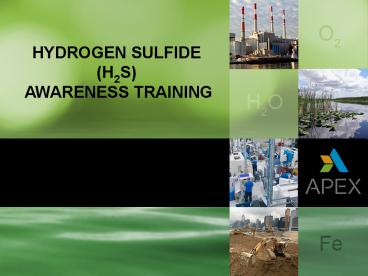HYDROGEN SULFIDE (H2S) AWARENESS TRAINING - PowerPoint PPT Presentation
1 / 20
Title:
HYDROGEN SULFIDE (H2S) AWARENESS TRAINING
Description:
PHYSICAL AND CHEMICAL CHARACTERISTICS PERSONAL DETECTION H2S also known as Rotten-Egg Gas or Sour Crude can be easily detected due to a strong odor of rotten eggs, ... – PowerPoint PPT presentation
Number of Views:1171
Avg rating:3.0/5.0
Title: HYDROGEN SULFIDE (H2S) AWARENESS TRAINING
1
HYDROGEN SULFIDE(H2S) AWARENESS TRAINING
2
HYDROGEN SULFIDE AWARENESS(H2S)
- Hydrogen sulfide presents a potential hazard to
workers at many work sites. - occurs as an unwanted by-product
- many different industries or occupations.
- ensure protection against exposure
- be aware of its properties,
- what to do in emergency situations.
3
HYDROGEN SULFIDE AWARENESS(H2S)
- Hydrogen sulfide is also produced by the
putrefication of organic matter. - It may accumulate in sewers, sewage treatment
plants.
4
PHYSICAL AND CHEMICAL CHARACTERISTICS
- highly toxic, poisonous gas
- deadly to humans
- has no visible color.
- It is soluble in hydrocarbons and water at a
ratio of 4 1, - highly corrosive to certain metals due to either
hydrogen embrittlement or sulfide stress
cracking.
5
PHYSICAL AND CHEMICAL CHARACTERISTICS
- flammable when mixed with air at a temperature of
500 degrees F, - lower flammability limit is 4.3 while the upper
flammability limit is 46 by volume in air. - When ignited, H2S produces Sulfur Dioxide (SO2)
which is extremely hazardous and may leave
victims disabled with pneumonia or respiratory
damage.
6
PHYSICAL AND CHEMICAL CHARACTERISTICS
- is 20 heavier than air, and can be dispersed
great distances with only a slight breeze - unidentified locations about refineries or
industrial settings could indicate detectable
levels of H2S - may include low lying areas such as utility
vaults, pits, ditches, trenches, confined spaces,
inside dikes, or poorly ventilated areas.
7
PERSONAL DETECTION
- H2S also known as Rotten-Egg Gas
- or Sour Crude
- can be easily detected due to a strong odor of
rotten eggs, or - to others, a sweet, offensive, sickening odor
8
PERSONAL DETECTION
- Although it can be detected at a low
concentration of 1 ppm, this early warning
property should not be depended upon as an
accurate indicator of its presence. - Hydrogen sulfide detection by your nose may not
occur as a concentration of this gas between 100
and 150 ppm can deaden your sense of smell.
9
HEALTH EFFECTS
- rapidly-acting systemic poison
- causes respiratory paralysis and asphyxia
- can irritate the eyes and respiratory tract at
low concentrations. - a concentration greater than 700 ppm, inhalation
may cause coma and/or death after a single
breath.
10
HEALTH EFFECTS
- Each individual person may be affected
differently by different concentration levels. - Some individuals are more sensitive.
- If you should smell the presence of H2S or hear
warnings from monitor alarms, then immediately
evacuate this area.
11
HEALTH EFFECTS
- Classed as a chemical asphyxiate
- Similar to carbon monoxide and cyanide gases.
- Inhibits cellular respiration and uptake of
oxygen, causing biochemical suffocation.
12
TYPICAL EXPOSURE SYMPTOMS
- 0 - 10 ppm - Irritation of the eyes, nose and
throat - 10 - 50 ppm - Headache, Dizziness, Nausea and
vomiting, Coughing and breathing difficulty - 50 - 200 ppm - Severe respiratory tract
irritation, Eye irritation / acute
conjunctivitis, Shock, Convulsions, Coma, Death
in severe cases
13
TYPICAL EXPOSURE SYMPTOMS
- Prolonged exposures at lower levels can lead to
- bronchitis,
- pneumonia,
- migraine headaches,
- pulmonary edema, and
- loss of motor coordination.
14
MONITORING
- Exposure should be minimized by employing
adequate engineering controls and safe working
practices. - Where engineering controls cannot adequately
control levels of exposure, it may be necessary
to supplement them with the use of suitable
personal protective equipment (PPE) such as
supplied-air respirators.
15
MONITORING
- Identification of hydrogen sulfide concentrations
may require monitoring. - The exposure limit should be set to alarm at a
concentration of 10 ppm.
16
FIRST AID
- First aid needs will depend on the concentration
level - Do not immediately rush to the aid of an affected
coworker unless properly trained and without
protecting yourself with proper PPE.
17
FIRST AID
- Signs and symptoms of an exposure
- respiratory paralysis by inhalation,
- burning sensation of the eyes due to contact,
- or skin irritation.
18
FIRST AID
- Inhalation - remove victim to fresh air
immediately. If not breathing, administer
mouth-to-mouth artificial respiration until
medical assistance arrives - If breathing is restored but slow and labored,
administer 100 oxygen by canister/mask as H2S is
rapidly detoxified by the body. - Maintain normal body temperature. Transportation
to medical services should follow immediately.
19
FIRST AID
- Eye or skin contact - should be treated by a 15
minute wash/flush at a safety shower/eye-wash
station. - If irritation or discomfort persists,
transportation to medical services should follow
immediately.
20
REFERENCES
- Regional poison control center 1-800-222-1222
Centers for Disease Control and Prevention
Public Response Hotline (CDC) 800-CDC-INFO 888-2
32-6348 (TTY) E-mail inquiries
cdcinfo_at_cdc.gov Centers for Disease Control and
PreventioN (CDC), National Institute for
Occupational Safety and Health (NIOSH), Pocket
Guide to Chemical Hazards































